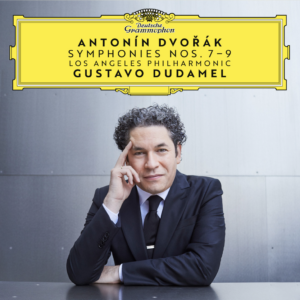Given the paucity over the last decade of Dvorák late symphonies recordings (not to mention complete cycles) it’s both surprising and pleasing to see this new release from Deutsche Grammophon featuring one of its front-line artists. But this shouldn’t be the case. The fact that since 2012 there have been at least nine new Brahms symphony cycles but only three of Dvorák’s 7-9 (and one of those is an arrangement for piano four hands) obliquely reinforces the notion that Brahms (the two were contemporaries and friends) was the greater composer when in fact the opposite is true. And it’s high-time for the musical world to admit this truth so Dvorák’s music can be more often played and recorded, thereby allowing the public to become more familiar with it.
So how does Gustavo Dudamel’s new recording factor into this? Well, like a glass of cool water for someone in the desert it’s a welcome relief to those used to only listening to older recordings. And as such, on first listen these performances are enjoyable as Dudamel leads them with freshness and lively energy. My colleague David Hurwitz said that Symphonies 7 & 8 “play themselves”, and they seem to do so here with Dudamel letting the Los Angeles Philharmonic have fun as they strut their musicianly stuff.
However, those long familiar with these works will sense something missing. For all the surface energy, Dudamel often doesn’t probe the musical depths the way Dohnányi or Harnoncourt do. Both these conductors explore and emphasize tonal colors (the Cleveland Orchestra horns for Dohnányi and the Concertgebouw brass for Harnoncourt) as well as novel and exacting articulation that disturbs as well as excites, whereas Dudamel merely achieves good orchestral balance and keeps everything well-blended. So we don’t hear the flange-like quality of the horns in the first movement of Symphony No. 7, nor do the timpani spike the rhythm at the close of the second subject. Are these sorts of things conductor enhancements? Perhaps, but they serve to heighten the music’s impact without distorting Dvorák’s intentions.
Thus, the Seventh’s finale is exciting (it can’t help but be), but misses the grinding tension of Dohnányi and Harnoncourt. Dudamel’s Symphony No. 8 comes off best, with free-spirited vibrance that’s quite fetching, even if rhythm and accents aren’t as sharply projected as his competition. This last also applies to the “New World” symphony. In his New York Philharmonic recording Leonard Bernstein’s solution was to invest the piece with forceful dynamic and propulsive energy, and boy does it work! Dudamel gets the propulsive part right, but falls short on dynamics and color.
Some of the fault lies with the recording. Disney Hall’s thickly reverberant acoustic makes mush of high frequencies, but also timpani strikes and string articulation (No. 9’s reference to “Turkey in the straw” sounds more like “Turkey in the oven”.) I kept feeling that the orchestra is making the right sounds, but they aren’t able to penetrate the aural gauze. Is it a bad sounding recording? Certainly not, as it boasts more dynamic range than Decca’s for Dohnányi, which was considered demonstration-class in its day. But his and Harnoncourt’s offer more clarity that lets individual instrumental color be better heard.
Luckily we live in a time when it’s not a major sonic sacrifice to choose 20-plus-years-old recordings over current ones. But this brings us back to the opening conundrum: do we have to keep playing the same old records? That’s the whole point of labels making new versions with new artists (or redos by old artists). Dvorák’s great symphonies deserve better than to be treated like second-rate music by the majors. So while Dudamel’s effort may not be perfect, it’s fine enough to rate a listen. And neophytes encountering this music on streaming services will be delighted with their discovery.
































